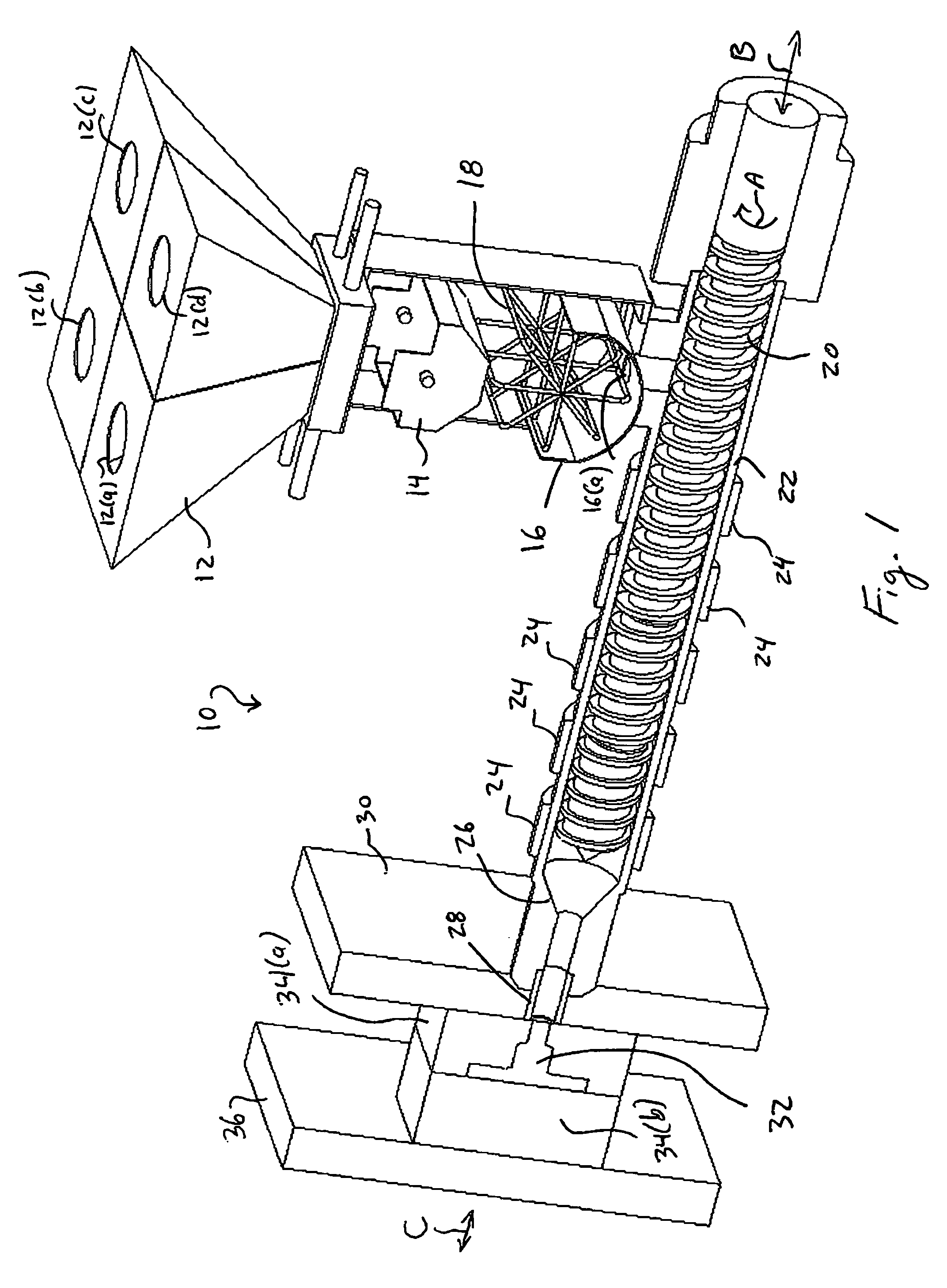Cross-linked thermoplastic polyurethane/polyurea and method of making same
a thermoplastic polyurethane and polyurethane technology, applied in the field of thermoplastic polyurethanes and thermoplastic polyureas, can solve the problems of poor performance characteristics of thermoplastic polyurethanes in tensile strength, rebound, compression set, unsuitable injection molding and extrusion applications, etc., and achieve good tensile strength, rebound, compression
- Summary
- Abstract
- Description
- Claims
- Application Information
AI Technical Summary
Benefits of technology
Problems solved by technology
Method used
Image
Examples
experiment 1
[0031
[0032]In this experiment, TEXIN 985 was used as the thermoplastic urethane base material. Different amounts of MDI in the form of MONDUR M were added to the mixture (ranging from 1% to 2% by weight of the total mixture). Diamine in the form of LONZACURE M-CDEA was also added to the mixture (in amounts ranging from 1% to 2% by weight of the total mixture). The barrel zone temperature was set at 380° F. (ejection nozzle). The remaining zones where set to 390° F. The material was post-cured at 200° F. for 12 hours.
[0033]Table 1 listed below illustrates the performance characteristics of the control (100% thermoplastic urethane base material) as well as three various weight percentages of MONDUR M and LONZACURE M-CDEA.
[0034]
TABLE 1ABCDBayer Testing Reference NumbersNB 893029ANB 893029BNB 893029CNB 893029DPercent of Base and AdditivesBayer StatedBase: 100%Base: 100%Base: 100%Base: 100%PresentMechanical(Control)Add-1: 1%Add-1: 1%Add-1: 2%Improvement OverPropertiesAdd-2: 1%Add-2: 2%Ad...
experiment 2
[0035
[0036]In this experiment, TEXIN 985 was again used as the thermoplastic urethane base material. Different amounts of MDI in the form of MONDUR M were added to the mixture (ranging from 1% to 2% by weight of the total mixture). Diamine in the form of either LONZACURE M-CDEA or LONZACURE M-DEA was also added to the mixture in amounts ranging from 1% to 2% by weight of the total mixture. HQEE was added in several runs ranging from 1% to 2% by weight of the total mixture (runs C, E, and F). Table 2 below illustrates the results of this experiment.
[0037]
TABLE 2ABCDEFBayer Testing Reference NumbersNB 893044ANB 893044BNB 893044CNB 893044DNB 893044ENB 893044FBase Bayer Thermoplastic UrethaneTexin 985Texin 985Texin 985Texin 985Texin 985Texin 985Percent of Base and AdditivesBayer StatedBase: 100%Base: 100%Base: 100%Base: 100%Base: 100%Base: 100%Mechanical(Control)Add-1: 2%Add-1: 2%Add-1: 2%Add-1: 2%Add-1: 2%PropertiesAdd-2: 2%Add-2: 0%Add-2: 0%Add-2: 1%Add-2: 0%for Texin 985Add-3: 0%Add-...
experiment 3
[0039
[0040]In this experiment, NOVEON ST80A was used as the thermoplastic urethane base material. MDI in the form of MONDUR M was added to the mixture (2% by weight of the total mixture). Diamine in the form of either LONZACURE M-CDEA or LONZACURE M-DEA was also added to the mixture in amounts ranging from 1% to 2% by weight of the total mixture. HQEE was added in several runs ranging from 1% to 2% by weight of the total mixture (runs I, K, and L). Table 3 below illustrates the results of experiment 3.
[0041]
TABLE 3GHIJKLBayer Testing Reference NumbersNB 893044GNB 893044HNB 893044INB 893044JNB 893044KNB 893044LBase Noveon Thermoplastic UrethaneST80AST80AST80AST80AST80AST80APercent of Base and AdditivesNoveon StatedBase: 100%Base: 100%Base: 100%Base: 100%Base: 100%Base: 100%Mechanical(Control)Add-1: 2%Add-1: 2%Add-1: 2%Add-1: 2%Add-1: 2%PropertiesAdd-2: 2%Add-2: 0%Add-2: 0%Add-2: 1%Add-2: 0%for ST80AAdd-3: 0%Add-3: 0%Add-3: 2%Add-3: 0%Add-3: 1%Add-4: 0%Add-4: 2%Add-4: 0%Add-4: 1%Add-4...
PUM
| Property | Measurement | Unit |
|---|---|---|
| temperature | aaaaa | aaaaa |
| temperature | aaaaa | aaaaa |
| Shore hardness | aaaaa | aaaaa |
Abstract
Description
Claims
Application Information
 Login to View More
Login to View More - R&D
- Intellectual Property
- Life Sciences
- Materials
- Tech Scout
- Unparalleled Data Quality
- Higher Quality Content
- 60% Fewer Hallucinations
Browse by: Latest US Patents, China's latest patents, Technical Efficacy Thesaurus, Application Domain, Technology Topic, Popular Technical Reports.
© 2025 PatSnap. All rights reserved.Legal|Privacy policy|Modern Slavery Act Transparency Statement|Sitemap|About US| Contact US: help@patsnap.com

